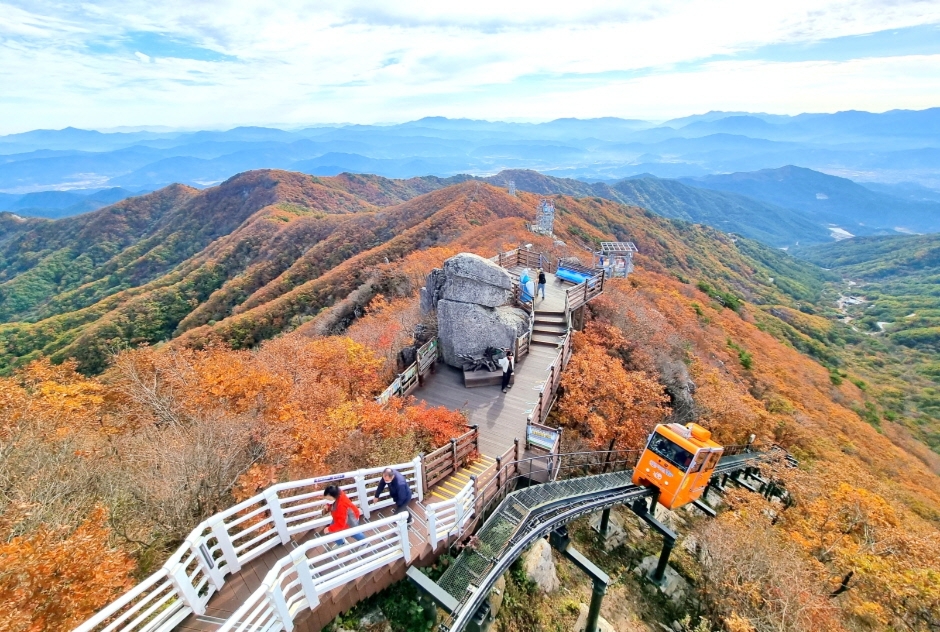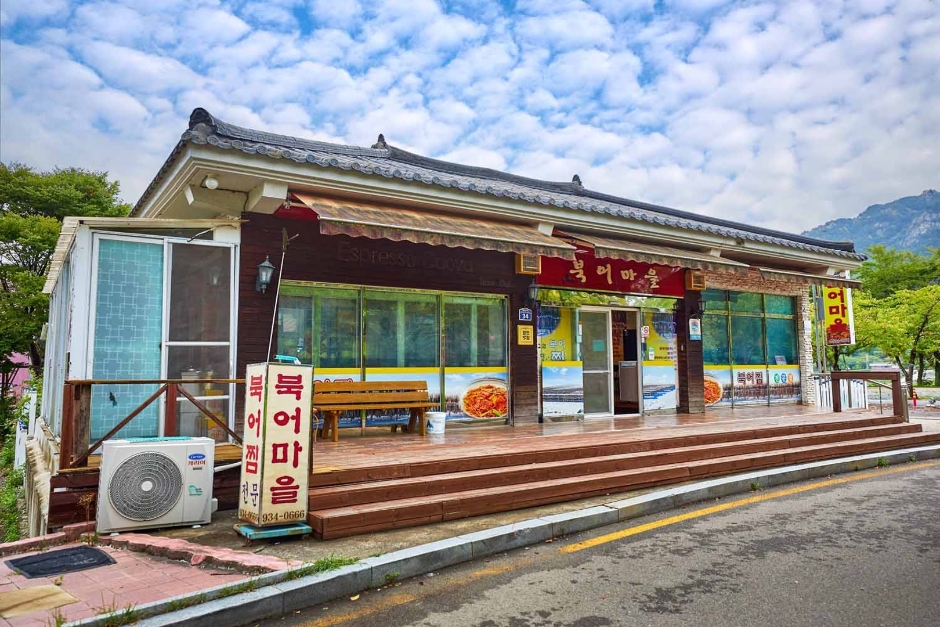Hamyang Daebong Mountain Valley Resort (함양대봉산휴양밸리)
17.4 Km 0 2024-02-21
331 Byeonggokjigok-ro, Byeonggok-myeon, Hamyang-gun, Gyeongsangnam-do
Hamyang Daebong Mountain Valley Resort is a recreation and tourism complex at the foot of Daebongsan Mountain in Hamyang. This resort boasts an array of attractions, including a mountain monorail and a zipline, offering exhilirating experiences amidst natural beauty. Addtionally, guests can enjoy various accommodation and and camping facilities, along with a forest park, blending adventure and relaxation seamlessly. The zipline itself, positioned 1,200 meters above sea level, spans an impressive length of 3.27 kilometers, providing an unforgettable aerial journey over the landscape.
Sancheongyulsuwon [Korea Quality] / 산청율수원 [한국관광 품질인증]
17.5 Km 13079 2020-09-10
36, Sindeunggahoe-ro Sindeung-myeon, Sancheong-gun, Gyeongsangnam-do
+82-55-974-0221, +82-10-9802-1132
Sancheong Yulsuwon was opened in October 2013 as traditional hanok accommodations to provide guests comfort and relaxation in nature. It was named after the expression from “Decade of Wen Wang” of the Classics of Poetry (the oldest existing collection of Chinese poetry), meaning “Following the virtue of ancestors, one should cultivate one’s mind,” in the hope that guests can experience traditional Korean culture in hanok and learn common themes and cultivate virtues in life. Located at the hanok street in Sancheong County, Gyeongsangnam-do Province, Sancheong Yulsuwon is a hanok stay facility established by Korea’s major education company JEI Corporation. It was built by expanding and renovating the Old House of Suncheon Park’s Clan for over four years. It is not only a hanok cultural facility but also an educational facility that aims to provide visitors comfortable relaxation and to establish a sound, rich environment of educational culture, which is also the philosophy of JEI Corporation. It is located around the Dumulmeori area where Dangyecheon Stream and Sindeungcheon Stream -- the water branch of Hwangmaesan Mountain (1,108m above sea level) -- meet. The area is known for many houses of noble families situated in a propitious site combined with mountains and water and as a hanok village with the old stone wall, which was designated as a cultural heritage. Among them, Sancheong Yulsuwon is an outstanding hanok structure built on a total area of about 2,975m2 according to the theory of divination based on topography.
Entering the main gate Yeongsumun, one sees the Anchae (inner house) situated in front, the outer Sarangchae (detached building) on the right, and the bathroom on the left. Then, there are the inner Sarangchae, the kitchen, and the pavilion around the vegetable garden and the pond. The arrangement of buildings has special meaning: the kitchen signifies a green dragon (east), the bathroom, a white tiger (west), the inner Sarangchae, an Ansan (a low and small mountain in front of the house), and the outer Sarangchae and the main gate, a Josan (a high mountain behind Ansan); these five buildings seem to embrace the Anchae. As for the special names of the buildings, the inner Sarangchae built with the splendid style of semi-hipped roof and double eaves was named “Nongam,” meaning “a thatched cottage of a skilled farmer”; the outer Sarangchae was named “Goheon,” meaning “an old sarangchae,” and the Anchae -- named “Hagyejae” meaning “modesty” -- is situated in the innermost area. In particular, its upper floor (numaru) offers an open view of the environment. The bathroom, which was named “Seoljodang” meaning “one should keep the mind and body clean,” is composed of two connected houses. It is also equipped with red clay sauna and jjimjilbang (Korean dry sauna).
Sancheong Yulsuwon was built based on a traditional hanok style of the Yeongnam area, with a splendid Seoul style of modernity added to the design. The sunshine comes through the windows made of hanji (Korean paper) in the clean and cozy rooms. Guests can also enjoy the outside view from the windows, which show the typical scenery of hanok consisting of jars, trees, flowers, and low stone wall with tiled roof. Every room is equipped with a bathroom including a bathtub and a modern-style kitchen. Sancheong Yulsuwon is adjacent to various tourist attractions including the following: valley of Daewonsa Temple surrounded by Geumgang pine trees; Namsa Yedamchon village, a village with an old wall made of red clay and stones; and Jeongchiwam Hermitage, Traditional Buddhist Temple No. 83 built by Silla’s Buddhist monk Uisang (625-702) and where the Buddhist Painting of Mountain Spirit can be found.
Jirisan Hanok Village [Korea Quality] / 지리산한옥마을 [한국관광 품질인증]
18.1 Km 11964 2024-04-07
43 , Daejeongbangcheon-gil, Namwon-si, Jeonbuk-do
+82-63-636-1003, +82-10-8107-1838
Jirisan Hanok Village, in Namwon-si, Jeollabuk-do, is a famous old house at the foot of Jirisan National Park’s Cheonwangbong and Nogodan Peaks. Just 20 minutes by car away from Nogodan and Baemsagol Valley Trail, the place is popular with walkers especially in the summer. Businessmen, poets and writers come here for the beautiful scenery; in particular, a candidate for the 2008 Nobel Prize in Literature stayed and worked here for a while.
Gamaksan Wind Farm (감악산 풍력발전단지)
18.6 Km 1 2024-02-23
San 57 Deoksan-ri, Sinwon-myeon, Geochang-gun, Gyeongsangnam-do
Gamaksan Wind Farm is a wind power complex located near the summit of Gamaksan Mountain in Geochang. The site, once a barren land, has been transformed into a flower garden with the planting of flowers such as Mother Chrysanthemum, Aster, Siberian Chrysanthemum, and Sliver Grass. It offers a panoramic view of Geochang-eup and Hapcheonho Lake. There are photo zones scattered throughout, providing excellent opportunities for photography. One of the main events is the Flower & Star Festival held in October. Visitors can enjoy vibrant purple asters and participate in programs like forest ecology experience and aromatherapy.
Bugeomaeul (북어마을)
19.4 Km 0 2023-12-22
34 Hoeyanggwangwangdanji-gil, Hapcheon-gun, Gyeongsangnam-do
Bugeomaeul is a bugeo jjim (braised dried pollack) restaurant located within Hapcheonho Hoeyang Tourist Resort, where visitors can get enjoy the best view of the lake. People often enjoy dried pollack as a braised dish in Korea. It is rich in protein and amino acids, known to prevent aging and improve liver function. Above all, it is an excellent detox food, and Koreans often eat bugeo jjim as a hangover food. Bugeomaeul uses their original sauce and recipe for a mouthwatering dish. The restaurant also has after-meal add-on options like noodles, which can be mixed with the remaining sauce for a more filling meal. The restaurant is located right in front of Hapcheonho Lake, allowing visitors to enjoy the meal comfortably with a pleasant sight in view.
[Jirisan Trail Course] Inwol-Geumgye
19.8 Km 5195 2024-04-06
308-1 Junggun-ri, Inwol-myeon, Namwon-si, Jeonbuk-do
Inwol-Geumgye Trail Course is part of the Jirisan Trail, starting from Inwol-myeon, Namwon-si, Jeollabuk-do, and passing through Deunggujae in Hamyang-gun, Gyeongsangnam-do, before reaching the village of Geumgye. Covering a distance of 20.5 kilometers, completing the trail typically takes around 10 hours, leading many travelers to plan a 1-night, 2-day itinerary. Along the way, hikers can enjoy the majestic landscapes of Jirisan Mountain, vast rice paddies, and visit six mountain villages.

![Sancheongyulsuwon [Korea Quality] / 산청율수원 [한국관광 품질인증]](http://tong.visitkorea.or.kr/cms/resource/07/2631407_image2_1.jpg)
![Jirisan Hanok Village [Korea Quality] / 지리산한옥마을 [한국관광 품질인증]](http://tong.visitkorea.or.kr/cms/resource/58/3042358_image2_1.jpg)


![[Jirisan Trail Course] Inwol-Geumgye](http://tong.visitkorea.or.kr/cms/resource/73/1918173_image2_1.jpg)
 English
English
 한국어
한국어 日本語
日本語 中文(简体)
中文(简体) Deutsch
Deutsch Français
Français Español
Español Русский
Русский